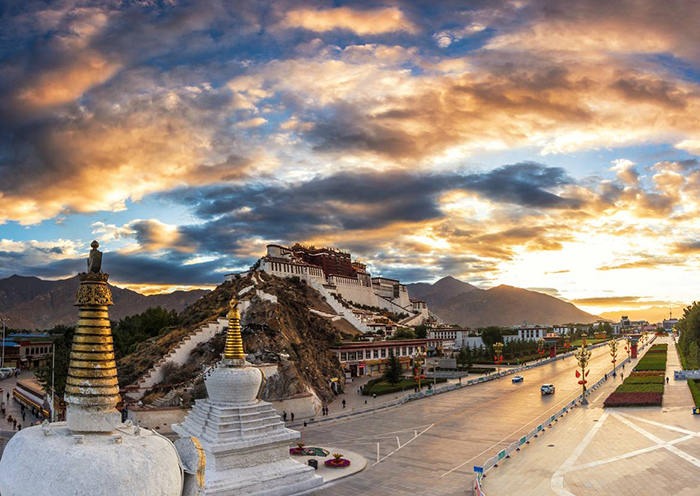Accommodation:Overnight in Shanghai
Next up is a visit to Yuyuan Garden, an ancient masterpiece of classical Chinese gardens. First constructed in 1559, Yuyuan consists of beautiful traditional architecture, water features, verdant green plants and rockeries that create an oasis of peaceful calm in the midst of modern Shanghai. Nearby is the Yuyuan Bazaar where you can try some traditional Shanghai snacks and shop for souvenirs and traditional Chinese handicrafts and works of art.
From the ancient to the new, we will move on to another of Shanghai’s popular attractions at Nanjing Road, a shopper’s paradise as well as a great place for a walk to experience the modern and vibrant atmosphere of the city. From Nanjing Road we will travel on to The Bund, which started off as a simple towpath for transporting goods from the river but eventually transformed into a world-class trading district. The Bund is a special area that fully reflects the fusion of Chinese and Western culture and architecture with the stunningly modern buildings of the new Shanghai skyline just across the river.
In the evening, we will take you to visit one of the most iconic buildings in all of Shanghai – the Oriental Pearl TV Tower. At 468 meters (1,535 feet) tall, the Oriental Pearl TV Tower was the tallest structure in China from 1994 to 2007. It features 15 different observatory levels, a small hotel, exhibition areas and an upper observatory level with a glass floor. The tower itself is lit up at night with everchanging LED lighting schemes, and it makes for an ideal place to to view the boats passing along the Huangpu River and The Bund across the river.
Accommodation:Overnight in Shanghai
After spending the day at Zhujiajiao, we will take you back to your hotel for the night.
Accommodation:Overnight in Shanghai
Tips for High Altitude Acclimatization:
1) Go for a leisurely walk in the fresh high altitude air, but avoid any strenuous activity after your arrival.
2) It's better to avoid taking a bath to avoid catching a cold.
3) Drink plenty of water to avoid dehydration, and eat some fresh fruit.
4) Get plenty of rest.
Accommodation:Overnight in Lhasa
From one historic landmark to another, your next stop will be at the Jokhang Temple, considered as the spiritual heart of Tibetan Buddhism. Every day thousands of pilgrims come from all over Tibet and other places to the temple to worship the Buddha. The Jokhang Temple is also known as the "House of Buddha" because it houses the precious Jowo Rinpoche, a life-sized (1.5 meter/5 feet) image of the Sakyamuni at the age of 12.
The last stop for today's Lhasa exploration is Barkhor Street, the wide, circular street that surrounds the Jokhang Temple. Local residents enjoy walking on the street, completing several circuits around the temple as a daily tradition of pilgrimage. The street also has many small shops selling a wide variety of traditional Tibetan goods, religious items and handicrafts.
After your visit to the Jokhang Temple, we will take you back to your hotel for the evening.
Tips for Visiting the Potala Palace
1. The number of visitors to the palace is strictly limited to 2,300 per day. Visitors can only visit during the time specified on the admission ticket.
2. Admission tickets to visit the Potala Palace are sold out almost every day, so it is strongly recommended to book your tickets several days in advance.
3. There are many steps at the Potala Palace, so it’s best to take it slowly to avoid possible altitude discomfort.
4. Visitors should respect the rules while visiting. Do not wear hats, wear revealing clothes or step on thresholds as these actions violate local customs.
5. Photography and the taking of videos are forbidden inside the Potala Palace.
6. A security search will take place at the entrance to the palace. Explosives, flammables, knives, lighters and even water bottles are not allowed inside the Potala Palace.
Accommodation:Overnight in Lhasa
After visiting the palaces and park at Norbulingka, we will travel around 5 kilometers to the western outskirts of Lhasa to visit the Drepung Monastery. The word "drepung" in Tibetan language means "prosperity". Since its establishment in 1416, Drepung Monastery has served as one of the most important Buddhist monasteries in Tibet. During its prime, more than 10,000 monks lived and studied in the monastery. Throughout its history, many important and famous Tibetan leaders studied at this monastery, including the Dalai Lamas. Accordingly, Drepung Monastery is also respectfully known as the “Mother School of Dalai Lamas”.
In the afternoon, we will escort you on to another famous monastery in Lhasa - the Sera Monastery. Sera Monastery is famous for its spectacular “Buddhist Debates”. As a daily routine, the monks gather in a courtyard, and debate on the various Buddhist doctrines with exaggerated gestures, which is thought to be helpful in facilitating a better comprehension of the Buddhist philosophy to attain higher levels of study. After enjoying the "Buddhist Debates", we will take you back to your hotel with the rest of the day and evening to relax or explore on your own.
Tips for Proper Etiquette While Visiting Monasteries
1) For clothing, shorts and/or bare shoulders are not allowed.
2) Hats and sunglasses should be removed before entering the chapels.
3) Taking photos is usually not allowed inside the chapels.
Accommodation:Overnight in Lhasa
Accommodation:Overnight in Lhasa
Today's Tips:
1) Please take care to pack all of your belongings, particularly the small things that are easy to forget about, such as phone and camera chargers, power adapters, mobile phones, wallets, etc.
2) If your flight or train is in the afternoon, please be sure to check out of your hotel room by 12 p.m.
Accommodation:None












































 Data in submission...
Data in submission...